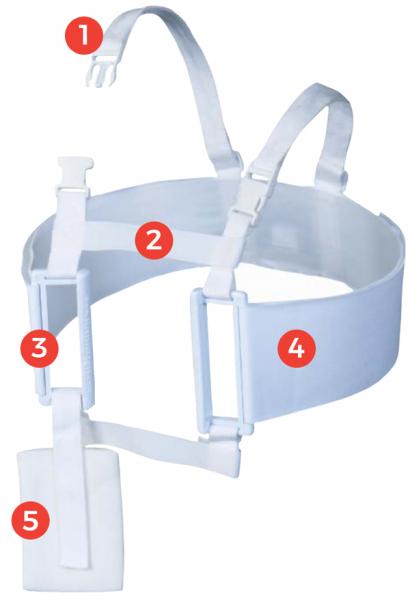
1Adjust shoulder straps so handles are at mid-sternum. (Shoulder straps are detachable) For women: handles go above breasts.
2Handles are parallel to each other, evenly spaced away from wound. If patient slides down when their bed is raised, HH may ride in back and handles will be too low: have patient lean forward while you tug down on the back of the chest strap to bring handles to mid-sternum.
3Pouch can be used for telemetry unit.
4Use Velcro® chest strap to adjust handles on each side so they are one hand width apart; fingertip to fingertip. Handles that touch or pass each other.
5Use the Velcro® retention straps (above and below handles) to hold handles in place.
Patient squeezes handles together with fingertips only whenever they cough, sneeze or move.
Decrease Pain, Increase Quality of Life
Heart Hugger is a simple, lightweight, and comfortable way to decrease and manage pain after thoracic surgery. It’s a simplistic system that is easy to size, fit, and put on (with the help of a nurse or loved one). Heart Hugger comes in multiple sizes and has many adjustable straps so it can be set to fit a wide variety of body types and sizes.
Sizing Before Surgery
The best practice with Heart Hugger is to measure, size, and adjust before surgery. This will be much easier on the patient and make it easy to help them slip on after surgery. First, take a few measurements to determine which size of Heart Hugger to purchase. For men, measure chest circumference at the nipple line. For women, measure above the breasts.
Heart Hugger sizing:
| GT 500-Small | GT 1000-Regular | GT 1500-Large | GT 2000-X-Large |
| 22”-38” | 36”-55” | 45”-72” | 50”-90” |
| 55-96 cm | 91-138 cm | 114-181 cm | 127-228 cm |
Adjusting the Straps
When sizing the patient, have them put on the Heart Hugger and then evaluate the chest strap. Adjust it so the handles are centered around the sternum with just enough space between them that the patient can grasp both handles with one hand.
Next, fasten the retention straps above and below the handles to help secure them in place. The handles should be as close to parallel and evenly spaced on either side of the wound as possible. Also, adjust the shoulder straps so the chest belt is comfortable and not digging into the armpits. Vertically, the handles should be mid-chest on men and above the breasts for women. More details on adjustments for fitting women can be found on the how to use page.
Putting the Heart Hugger on After Surgery
To put the Heart Hugger on when the patient is out of surgery, detach the shoulder strap from the handle on one side and slide the handle under the patient’s arm. Bring the shoulder strap over the shoulder and reattach it. Next, help the patient lean forward and help adjust the chest strap so it lies flat on the patient’s back (like you’re helping them put on a backpack). Then lean them back, and attach the other shoulder strap in the same way as the first.
Important note: Make sure the patient does not try to reach back as you assist them into the Heart Hugger. This can be very painful and could injure the surgical wound. Instruct the patient to keep their elbows close to their sides.
To discuss sternal support options,
